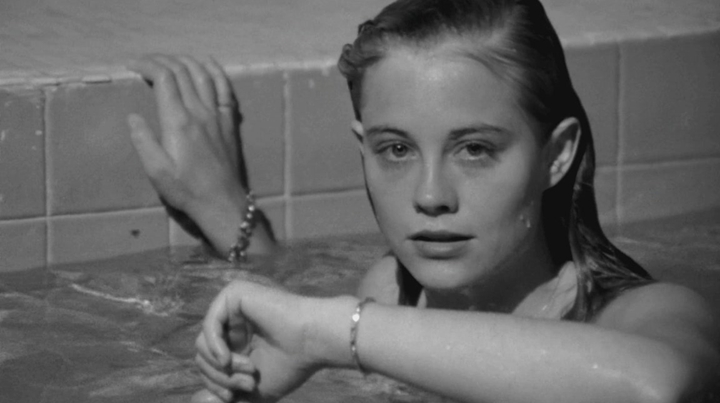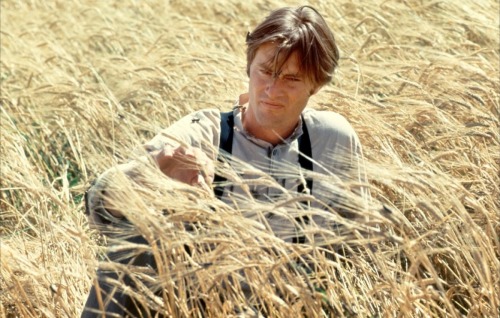 |
| Hold on, getting a poster of this in my room right now. |

 |
| Hold on, getting a poster of this in my room right now. |
Ben Affleck pulled off the impossible and made a movie about the making of a movie that isn’t cheeky or ironic. Then again, it’s hard to be overly ironic when the movie you’re making is fake and you’re dealing with a hostage crisis.
“Argo” plays perfectly like a classic thriller: it’s smart, suspenseful, and fun. “Argo” is both an entertaining thriller and a disturbing document of a very bad time in history.
“Argo” is equal parts reenactment, documentary footage, and artistic license. It starts off with a nice refresher on the past 60 years of Iranian history. In just about a minute, it makes much more sense out of what happened to that country than CNN, MSNBC, and Fox News ever could combined. It goes up to 1979, the year in which the Shah was overthrown and the Iranian Revolution began. Director Ben Affleck gives us a full fledged reenactment of the Iranians breaking into the US Embassy in Tehran. This scene would have felt overlong, if it wasn’t so important to the rest of the story, and directed with nail-biting intensity.
Actually, “Argo” is not about the hostages in the Embassy but rather a select few that nobody knew even escaped. A group of Americans hid out in the Canadian Embassy. The Canadians didn’t quite bother the Iranians as much as the Americans did, as the Canadians never seem to bother anyone, as they are the greatest country ever to exist.*

But I digress. The CIA needs a way to safely get the Americans out of the Canadian Embassy and back to America. Tony Mendez (Ben Affleck) is on it. Tony is good at his job, and, like almost any government agent on film, he just wants to get home and see his son. You’ll hear more about this later in the review.
Tony and his boss Jack O’Donnell (Bryan Cranston) go through every option and can’t find a logical way to sneak the Americans out of Iran. As O’Donnell, Cranston is much more subdued than I’m used to seeing him. But then again, anyone in government who’s most concerned with following orders isn’t going to chew up the scenery. As the clock ticks, no idea seems to work. That is, until Tony comes up with the craziest idea ever: shoot a fake movie in Iran, and sneak an entire fake crew out of the most dangerous country in the world.
“Argo” is a heist film in which the big heist involves the making of a movie. This is the kind of story that can make any film buff go crazy. When rescuing the Canadian hostages, Tony tells them that they all must assume the roles of certain members of a film crew. They must learn and memorize their backstories for when they are questioned at the airport. They are essentially memorizing characters and becoming a part of a lie. While making a fake movie, they are essentially acting one out in real life. And we, of course, are seeing that movie be acted out in real time.
To make this fake movie come true, Tony goes to Hollywood make-up artist John Chambers (John Goodman) who then brings him to legendary producer Lester Siegel (Alan Arkin, who utters a line of dialogue that has already become classic). They bring Tony a script for “Argo,” a B-grade sci-fi film that could be filmed perfectly in the Middle East. They have their cover. It is too bad that the “Argo” within “Argo” never got mad. I’d really like to see this tale of overthrowing a king on a distant planet. The story of the sci-fi “Argo” actually sounds alarmingly similar to what was happening in Tehran during that time. Get on it, Affleck.

“Argo” marks Affleck’s third time behind the camera. With every feature, he gets better and better as a director. He directs “Argo” like a confident, old pro, and not just a young director still searching for his voice. Behind the camera, Affleck is someone who is incredibly well versed in both movies and the art of filmmaking. As he also showed with “The Town,” Affleck has a talent for strictly following genre conventions yet also making them fresh and exciting. He has conquered the chase scene. Towards the end of “Argo,” there is one chase that totally puts any chase in “The Town” to shame. Some of the final chase in “Argo” might be fictionalized, but Affleck knows that part of showing history on film is bending the truth a little bit. After all, even in a story as exciting as this one, facts can be boring.
Sometimes, the cinematic conventions that “Argo” follows work to its advantage, and other times not. While I understand that Affleck just wanted a strong back story for Tony, I would not have minded if they just completely removed everything about his estranged family. It didn’t make Tony any deeper or more complicated as character. All I wanted to see was Tony at work, and how his job effected him. “All the President’s Men” didn’t need to show personal relationships in order to flesh out Woodward and Bernstein. In a movie about the workplace, showing someone being good at their job can often be enough to bring out character.
I am not against character development. However, I am against character development that turns the character into a prototype rather than a human. I can site a more recent example, actually also about the CIA, in the show “Homeland.” The most important details about the CIA Operative main character are how her mind functions and how that effects her job. Tony’s relationship with his son didn’t effect his job. His job effected his relationship with his son. This was mentioned several times, but never explored deep enough. There was one possible ending nestled in “Argo” that would have been a little darker, yet absolutely perfect. Instead, the ending they went with pushes a little too hard to tie things together nicely. Hard-boiled thrillers should never end with a perfectly tied little bow on them.
But maybe I am being a little tough here. After all, Tony’s relationship with his son is partly forged on a love for movies. If it wasn’t for his son watching “Battle of the Planet of the Apes,” Tony might never have thought of his crazy rescue idea. There is something wonderful about the nature of cinema that I think “Argo” showed flawlessly: movies can connect two estranged people, or two people from completely different cultures, in a way that most other art forms can’t. The idea of a story can cross a threshold even if two people don’t even speak the same language. “Argo,” in simplest form, is a love letter to filmmaking. Pay very close attention to the graininess of every shot. That’s on purpose. This could be one of the last times you see a movie that’s actually shot on film.
*Note: I am not Canadian, and they are not the greatest country ever. However, I am a big fan of their country.

“You ain’t ever gonna amount to nothing.”
The first and last shots of “The Last Picture Show” are nearly identical. However, one is in reverse of the other. The movie marquee, once presenting the next showing, is now empty. After the last picture show has ended, there is not much left to do.
“The Last Picture Show” is such a vivid and knowledgeable portrayal of life in a small Texan town, that it would seem only to come from memory. Yet, director Peter Bogdanovich grew up in Kingston, New York, a place bearing no resemblance to rural Texas. He’s just that good of a filmmaker.
“The Last Picture Show” takes place in the fictional town of Anarene where football is king. This was long before “Friday Night Lights” ever came to be. Except here, none of the action takes place on the field, so glory is even harder to find.
From start to finish, “The Last Picture Show” is powered by the country tunes playing on everyone’s radios, primarily those of Hank Williams. In Anarene, which becomes a character itself, the greatest means of escape are the pool hall and the movie theater, especially that movie theater.

“The Last Picture Show” is a coming of age story in which the teenagers mature in a world that is not vibrant or cultured but instead rather bleak. Think the opposite of “American Graffiti.” As the film progresses, the culture diminishes more and more.
Instead of beginning with dialogue, “The Last Picture Show” starts off with the voices of disc jockeys and the music on the radio, perhaps the guiding voice of that generation. “The Last Picture Show” primarily follows the town’s star football players Sonny Crawford (Timothy Bottoms) and Duane Jackson (Jeff Bridges). Sonny is kind and sensitive and in a relationship with a girl he does not love (Sharon Taggart). Their relationship will not last long. Duane, meanwhile, is confident, handsome and popular. He is first introduced while dating the beautiful Jacy Farrow (Cybil Shepard), Anarene’s equivalent of a movie star; a goddess wearing a scarf. In this drab setting, she is a human oasis.
Everything is in order until trouble comes during Christmas. After a holiday party, Sonny befriends and later has an affair with Ruth Popper (Cloris Leachman), his football coach’s wife. Ruth is miserable and despises her husband, but says she married him as a way of angering her parents. At a time when Hollywood favored youth rebellion against those who raised them, “The Last Picture Show” actually ends up being about a sacred respect for one’s elders. After all, everyone feels a need to rebel at one point or another.

That is what makes this film such a unique coming of age story: it is as much about the adults coming of age as it is about the kids. Coming of age, after all, is the act of discovering how one is supposed to act at a given time in their life. This act can occur more than once during one’s life.
The boys all end up vying for the affection of Jacy. This will eventually lead to each of their downfalls in one form or another. “The Last Picture Show” is less a story as a whole as it is a mosaic of little stories that fall together into a vivid, haunting, yet beautiful, whole. A road trip to Mexico that happens entirely offscreen and a pool hall given to Sonny in an inheritance are just two of the many threads tied together to make a whole. These events don’t need to be seen to have an impact. Watching “The Last Picture Show” brought to mind “On the Waterfront” and the disenfranchised teen rebels of “Rebel Without a Cause.”
Like these movies, “The Last Picture Show” also has a strong emphasis on the little moments that are often ignored in everyday life, yet can’t be ignored in front of a camera. Moments like the one in which Ruth struggles to get her shirt over her head felt improvised, like the moment in “On the Waterfront” when Terry (Marlon Brando) fiddles with Edie’s (Eva Marie Saint) glove. There is something funny and tender about moments like these that make the characters feel vulnerable and achingly real.

In a way, “The Last Picture Show” is not about the loss of innocence leading into the Korean War, but rather about how that innocence was never there to begin with. In Anarene, there is no difference between public and private lives. Jacy and Sonny’s impulse marriage begins partly because Jacy is bored, and partly because she wants to be the talk of the town.
“The Last Picture Show” contains some outstanding work from multiple actors who would continue to make a great impact on cinema. Bridges creates slick, confident characters who you always want to follow, no matter how egotistical or lazy they may be (the lazy part refers to a different movie, of course). So many sides of each character are seen and at one point or another, everyone of them seems either emotional or emotionless. For example, the film’s most indelible scene comes during skinny-dipping at rich boy Bobby’s (Gary Brockette) house. As Jacy gets up in front of everyone to undress, her insecurity is seen in the way she clumsily undresses, and at that moment she becomes more than a spoiled, shallow beauty queen. It might have helped that this was actually Shepard’s first nude scene. No one ever feels like they are acting: they seem to feel so free and comfortable in the skin of their characters that they are simply just existing in their roles. That also comes from the screenplay written by Bogdanovich and Larry McMurtry (who wrote the book that this film is based off of), which is so deeply invested in the local dialect. “The Last Picture Show” comes closer to achieving naturalism as most films ever will.

Despite the lack of culture in Anarene, the bits and pieces of cinema and music throughout aid in telling this story. Think about the clip of “Red River” shown in the theater. Bogdanovich chose it for a reason. Hank Williams’s “Why Don’t You Love Me” is a perfect sendoff song and it provides a melancholy epilogue about how hard it becomes to enjoy what we used to enjoy as we age. Not that the haunting last images needed to be explained, but the song certainly provides the right backdrop.
It would probably be hard to see something like “The Last Picture Show” get made nowadays. Bogdanovich has no shame ending without something uplifting to cling onto. However, that is what helps make the story feel so much more real, as it acknowledges that life doesn’t always end with a big, bright ribbon tied to it. Even the healing and uniting power of movies, which the boys depend on, can’t be relied on anymore, as the theater closes its doors. “The Last Picture Show” will remind you that sometimes closure is not the most rewarding way to end a movie.
Here’s an Idea Hollywood: A modern day update of “The Last Picture Show” about the closing of a small town video store. Boom. I expect to be paid now.
Because even Broadway is afraid of green-lighting an original concept, Universal Pictures Stage Productions announced today that “Animal House: The Musical” is currently in development. At times like these, I look around to make sure reality isn’t actually some giant artistic social experiment by Banksy.
If this didn’t sound cruel enough already to the “Animal House devotees of the world, the news was announced today on the 30th anniversary of John Belushi’s death. So instead of talking about how Belushi transformed comedic acting in such a short amount of time, everyone is talking about “Animal House: The Musical” (yes, I am guilty of this too). Turning “Animal House” into a musical would be a disservice to everything the brothers of the Delta House stood for. “The Lion King” lent itself to a successful musical because it already was one, and “Hairspray” lent itself well to the format (even if it sacrificed some of John Waters’s best black humor). And for every “Saturday Night Fever,” there is a “Carrie.”
“Animal House” is the kind of story that wouldn’t function as well in today’s world, as so many knockoffs immediately followed it. But instead of discussing this, honor Belushi (and “Animal House”) with these great clips after the jump:
After this past Sunday’s ceremony ended, I promised everyone I was done with the Oscars for at least the next few months. But as they say in just about every action movie ever made: “just when I thought I was out, they pulled me back in.” What I have today is a great clip I was sent this morning of Steven Spielberg reacting to the Oscar nominations in 1976. In the previous year, “Jaws” took audiences by storm. In this clip, Spielberg is none too pleased to find out that despite a Best Picture nomination for “Jaws”, the Academy failed to recognize his directing.
Spielberg blames his snub on commercial backlash. That is a possibility, as most of the nominations in the past few years have been for lower grossing movies. But then again, no one is going to nominate “Transformers” or “Breaking Dawn” for Best Picture. I am guessing the real case is that Spielberg just missed the shortlist, given that the nominated directors were Milos Forman, Sidney Lumet, Stanley Kubrick, Robertrt Altman, and Federico Fellini. That’s a hard group to compete with.
Anyway, this is a great video to give you some insight on what filmmakers think of the Oscars. It will also give you a hint of what the 1970s was like. Its an especially different Spielberg than we were used to, a man who was fighting the system before he ultimately became it.
Watch the video after the jump:
 Watching a Terrence Malick film is like taking a stroll through nature. Or in the case of “Days of Heaven,” harvesting it, burning it, and possibly getting killed by it.
Watching a Terrence Malick film is like taking a stroll through nature. Or in the case of “Days of Heaven,” harvesting it, burning it, and possibly getting killed by it.






 “Grab your mother’s keys we’re leaving.”
“Grab your mother’s keys we’re leaving.”



 “This is where I live. This is me.”
“This is where I live. This is me.”

 Something very interesting happened while I was watching “Black Dynamite.” For about an hour, I understood what it was getting at, and what it was trying to do. At that, it was doing well. What I couldn’t help but wonder was: where’s the big punchline?
Something very interesting happened while I was watching “Black Dynamite.” For about an hour, I understood what it was getting at, and what it was trying to do. At that, it was doing well. What I couldn’t help but wonder was: where’s the big punchline?
 The next time somebody says to you, “they don’t make ‘em like they used to,” know that they’re likely talking about “The Conversation.” Nobody observes time and space while fully exploiting all the great elements of film quite like Francis Ford Coppola did.
The next time somebody says to you, “they don’t make ‘em like they used to,” know that they’re likely talking about “The Conversation.” Nobody observes time and space while fully exploiting all the great elements of film quite like Francis Ford Coppola did.